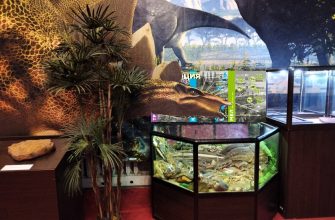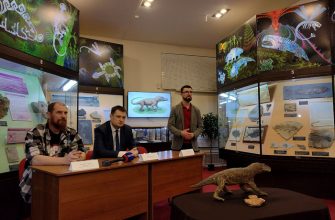A.U.Khlyupin
During the next stage there was a partial washing over and reworking of previously deposited rocks. Strong water streams came from the Urals, eroding deep channels (tens meters deep and 100-200 meters across) in the clay sediments, developing a ramified river system. The modern river is doing much the same thing, cutting a deep valley in the Permian sediments, creating a 60 meter high precipice. In the bottom part of these streams large fragments of rock were deposited, followed by large grainy sandstones, and where the stream lost its energy and speed, silt. There was also the formation of precipitates of hydro-carbonate of calcium, followed by the formation of thick grey calcarious sandstones. About five such fossil river beds are preserved on the territory of locality.
Continental sediments of Permian age were covered by hundreds meters of younger sediments-Mesozoic and Cenozoic-lasting during the last 230 million years. We don’t know if it would have been possible to find sediments of Permian age (and the remains of the ancient reptiles they contain) on the earth surface if these younger sediments were not eroded by strong glaciers, which produced the modern relief in the Quaternary Period, and if there were no large rivers, which made the deep river valley. Concurrence all these and many other circumstances affected the formation of the Kotelnich locality, permitting the collection of abundant fossil material every year and the study of the structure of sediments, and allowing the investigation of events that took place 250 million years ago.

Bone bearing horizons are exposed in a river bank section, unveiling new material with the annual spring floods of melted snow and ice. Finding bones is possible only when the surface of the section was well washed by water, which removes scree, turf and plants. Unfortunately, when the remains of animals are found they have already been exposed to degredation. Sometimes only a fragment is left from a formerly completely skeleton, and the rest of it was destroyed by the river. One finds completely skeletons by seeing only few nearly imperceptible bones exposed on the surface. It’s a race to save the fossils from inevitable destruction by nature factors, water first among them.

Upon exposure, bones bearing rocks loose water leading to cracking and increased friability of the fossils. Its one more factor affecting the quality of the fossils. However, for the unprecedented quality of preservation of fossils from the locality, and their exposure to the surface leading to their eventual discovery and study, we are obliged first of all to the constant presence of water.






